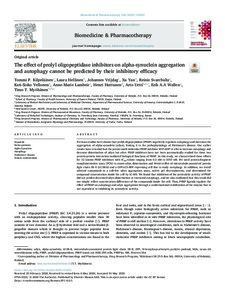The Effect of Prolyl Oligopeptidase Inhibitors on Alpha-Synuclein Aggregation and Autophagy Cannot Be Predicted by Their Inhibitory Efficacy
Tommi P Kilpeläinen; Laura Hellinen; Johannes Vrijdag; Xu Yan; Reinis Svarcbahs; Kati-Sisko Vellonen; Anne-Marie Lambeir; Henri Huttunen; Arto Urtti; Erik A A Wallen; Timo T Myöhänen
https://urn.fi/URN:NBN:fi-fe2021042821927
Tiivistelmä
Previous studies have shown that prolyl oligopeptidase (PREP) negatively regulates autophagy and increases the aggregation of alpha-synuclein (αSyn), linking it to the pathophysiology of Parkinson’s disease. Our earlier results have revealed that the potent small molecular PREP inhibitor KYP-2047 is able to increase autophagy and decrease dimerization of αSyn but other PREP inhibitors have not been systematically studied for these two protein-protein interaction mediated biological functions of PREP. In this study, we characterized these effects for 12 known PREP inhibitors with IC50-values ranging from 0.2 nM to 1010 nM. We used protein-fragment complementation assay (PCA) to assess αSyn dimerization and Western Blot of microtubule-associated protein light chain 3B II (LC3B-II) and a GFP-LC3-RFP expressing cell line to study autophagy. In addition, we tested selected compounds in a cell-free αSyn aggregation assay, native gel electrophoresis, and determined the compound concentration inside the cell by LC-MS. We found that inhibition of the proteolytic activity of PREP did not predict decreased αSyn dimerization or increased autophagy, and we also confirmed that this result did not simply reflect concentration differences of the compounds inside the cell. Thus, PREP ligands regulate the effect of PREP on autophagy and αSyn aggregation through a conformational stabilization of the enzyme that is not equivalent to inhibiting its proteolytic activity.
Kokoelmat
- Rinnakkaistallenteet [27094]
